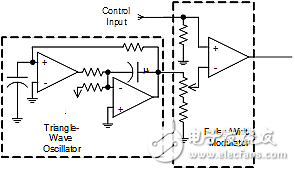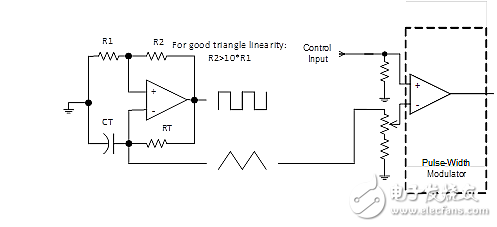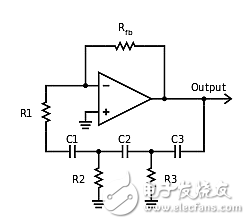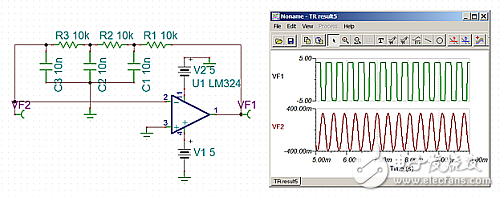A recent colleague was tasked with recommending a simple pulse width modulation circuit to the customer. The most straightforward method might be to place an oscillator with a square wave output, and then use an integrator to provide a triangular waveform to the comparator with its control input for the pulse width, as shown in Figure 1. Although the circuit works fine, I want to tell my colleagues how to use the input as an output to save an op amp.

Figure 1: A method of implementing a pulse width modulator.
You can use the classic op amp (or comparator) relaxation oscillator to save one of the op amps, using the oscillator capacitor signal as the source of the triangle wave. It must be noted that for large amplitudes of capacitors, the waveform is more exponential and non-linear. As the capacitor swing decreases, the linearity improves. In general, if the capacitor swing is an order of magnitude lower than the amplifier or comparator output, it has a fairly good linearity. The reduced level is the result of selecting a positive feedback value that provides a conversion level of approximately one tenth of the output at the input. But the point of this article is to introduce a concept that takes the usual input of the circuit as an output because it provides the required waveform. This concept is shown in Figure 2.

Figure 2: Using the input as an output to provide a triangular wave for the duty cycle comparator.
If you need a sine wave, you can also use the technique of using the input as an output. In this case, use the classic phase-shift oscillator, which always appears in the high-pass phase-shift network:

Figure 3: Phase-shifted oscillators are most common in Qualcomm feedback networks.
A sine wave can be obtained using a low pass network. The output is still a square wave, but the input to the circuit is a fairly nice square wave. It is not the most advanced circuit because of low distortion, but it is really clean.
Figure 4 shows a schematic and simulation of a phase shift oscillator for generating a sine wave.

Figure 4: Using a low-pass network on a phase-shifted oscillator provides a pretty sinusoidal signal at the inverting input. Never underestimate the power of using input as output.
Advantages of Self Wrapping Split Braided Sleeving to to tightening the power cord wire for protection;
With excellent flexibility, flame resistance, wear resistance and heat insulation.
Strong corrosion resistance and abrasion resistance.
Excellent softness, easy to bend.
Durable in use.
Can be used for wire and cable protection, pipe and hose, indoor wiring etc.
It offers durable abrasion resistance in a wide range of industrial applications.
The open weave construction allows an easy installation on a bundle of hoses and cables, even if some with bulky or large connectors.
Totally expanded the sleeving can reach at least one point five times than the initial dimension.
Structure of PET Self Wrapping Split Braided Sleeving
Expandable sleeving is braided with environment-friendly polyester monofil. (PET, PA6, PA66, PPS), It possesses good flexibility, fire resistance, abrasive resistance and thermal insulation performance. The sleeving owns smooth surface, bright color, various patterns.
Pp Braided Sleeve,Pp Self Closing Sleeve,Pp Expandable Braided Sleeve,Pp Wire Harness Protection Tube
Shenzhen Huiyunhai Tech.Co.,Ltd , https://www.hyhbraidedsleeve.com